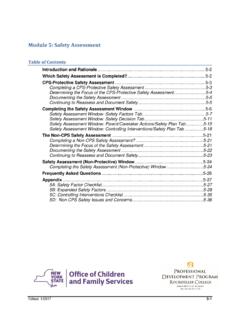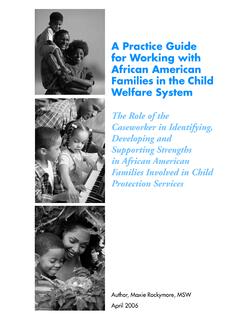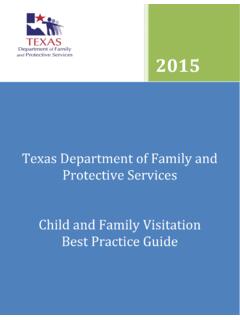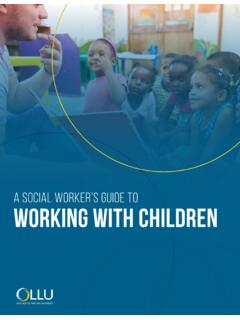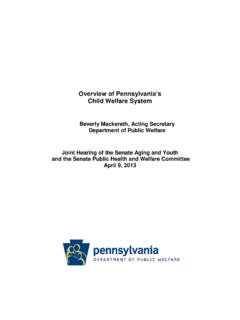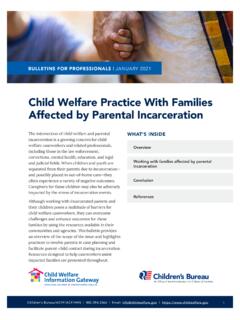Transcription of Human Trafficking and Child Welfare: A Guide for Child ...
1 Children s Bureau/ACYF/ | Email: | S INSIDEB ackgroundFederal legislation and initiativesUnderstanding victim needsStrategies for State and local agenciesConclusionAdditional resourcesReferencesBULLETIN FOR PROFESSIONALSJuly 2017 Human Trafficking and Child welfare : A Guide for Child welfare AgenciesThe growing awareness of Human Trafficking in the United States and abroad requires government and Human services agencies to reevaluate old policies and develop new ones for identifying and serving victims. Due to their potentially unstable living situations, physical distance from friends and family, traumatic experiences, and emotional vulnerability, children involved with Child welfare are at risk for being targeted by traffickers who are actively seeking children1 to exploit. Therefore, it is imperative that Child welfare agencies be at the forefront of the response to and prevention of Human Trafficking .
2 Additionally, recent Federal legislation established new requirements for Child welfare agencies related to identifying and serving minor victims of Human Trafficking . 1 For the purposes of this report, the term children includes youth. The term youth is used when source materials specifically reference that 201y77htph s2y :2/wh. :i27a12/wh. thir2 This material may be freely reproduced and distributed. However, when doing so, please credit Child welfare Information Gateway. This publication is available online at d Welfar e Information Gateway has developed a companion Guide to this publication to assist Child welfare caseworkers. Human Trafficking and Child welfare : A Guide for Caseworkers is available at Human Trafficking is by no means a new issue, in recent years public agencies have strengthened their focus on its identification and prevention as well as treatment for its victims.
3 The following provides information about the definitions of Human Trafficking , the scope of the problem, and the connection with Child citizens and foreign national children can be victims of Human Trafficking within the United States. Federal law generally categorizes severe forms of Trafficking in persons into either labor Trafficking or sex Trafficking . Labor Trafficking . Per the Trafficking Victims Protection Act of 2000 (TVPA), which is part of the Victims of Trafficking and Violence Protection Act of 2000 ( 106-386), labor Trafficking is the recruitment, harboring, transportation, provision, or obtaining of a person for labor or services through the use of force, fraud, or coercion in order to subject that person to involuntary servitude, peonage, debt bondage, or slavery. The definition of labor Trafficking in the TVPA does not distinguish between children and adults, which means that children also must encounter force, fraud, or coercion to be victims of labor Trafficking .
4 Examples of labor Trafficking include agricultural or domestic service workers and travelling sales crews that force children to sell legal items ( , magazines) or illegal items ( , drugs). Sex Trafficking . The TVPA, as amended, defines sex Trafficking as the recruitment, harboring, transportation, provision, obtaining, patronizing or soliciting of a person for the purpose of commercial sex. While adults must be compelled to perform commercial sex by force, fraud, or coercion in order for it to be considered a severe form of Trafficking in persons, this is not the case for children. By law, children under the age of 18 who are induced to engage in a commercial sex act are considered victims of sex Trafficking . In addition to a minor engaging in a sex act in exchange for money, examples of sex Trafficking include a minor engaging in survival sex ( , the victim engages in sex in order to obtain basic needs such as food, shelter, or clothing, which are considered something of value) or participating in certain types of in the Child welfare and related fields typically use both the words victims and survivors to refer to individuals who have experienced or are experiencing Human Trafficking .
5 The use of the term victim has legal implications for foreign nationals in terms of their eligibility for services, legal standing, and rights, whereas the term survivor is frequently used to connote the strength and resilience of individuals who were exploited through Human Trafficking . Although the terms are sometimes used interchangeably in the field, this bulletin uses the term victim while still acknowledging the strength and resiliency of those who have been trafficked. Individual victims may have their own preference for how they would like to be bulletin is intended for Child welfare agency leadership and explores how Child welfare agencies can support children who have been victimized as well as children that are at greater risk for future victimization. It provides background information about the issue, including its scope and relevant legislation and initiatives, and strategies that agencies can implement to address the Trafficking of children.
6 State and local policy and program examples also are 201y77htph s2y :2/wh. :i27a12/wh. thir3 There are several common misperceptions about Trafficking (Center for the Human Rights for Children & International Organization for Adolescents, 2011): Myth: Trafficking always involves transporting the victim across State, country, or other : This is not included in the Federal definition of Trafficking . An individual can be recruited and exploited for labor or commercial sex without having crossed any borders. Myth: All Human Trafficking victims in the United States are from other : Trafficking victims may be citizens or foreign nationals. Myth: Individuals must be physically restrained or locked up to be a : While some victims may be physically held by their trafficker, psychological means of control ( , trauma bonds, threats, coercion) are far more more information about how States classify Human Trafficking , view Information Gateway s Definitions of Human Trafficking at of Human TraffickingThe exact number of Child victims of Human Trafficking in the United States is unknown, and trying to determine the number is difficult.
7 The number of exploited children or children at risk for exploitation varies widely from source to source, often due to differences in definitions and methodologies (Finklea, Fernandes-Alcantara, & Siskin, 2015). Challenges to data collection include victims of Trafficking not self-identifying due to factors such as complex trauma, trauma bonds, and normalization of victimization. Additionally, victims may fear talking to authorities, distrust service providers, or may have been coached by their traffickers on what to say while talking to others. These factors, among others, often make it difficult for those screening for Trafficking victims or collecting data to recognize victims. For a more thorough discussion of the issues surrounding data collection, see Chapter 2 of Confronting Commercial Sexual Exploitation and Sex Trafficking of Minors in the United States, a product of the National Academy of Science, at #page=58.
8 Nonetheless, there are various studies and organizations that provide a glimpse at how many children may be victims of Human Trafficking . The National Human Trafficking Hotline, a resource supported by the Administration for Children and Families (ACF) within the Department of Health and Human Services (HHS), received reports for 5,544 potential cases of Human Trafficking in 2015, with 1,621 of those cases referencing minors. For all cases, 75 percent involved sex Trafficking , 13 percent involved labor Trafficking , and 3 percent involved both types (National Human Trafficking Resource Center, 2016). One in six of the more than 18,500 children reported to the National Center for Missing and Exploited Children (2017) as missing were the victims of Child sex Trafficking . It is important to remember that existing national data are not reliable indicators of the prevalence of Human Trafficking .
9 The true prevalence of sex and labor Trafficking is unknown, and most service providers believe that these statistics underestimate the scope of the are several Federal initiatives to collect data on Human Trafficking victims. For example, HHS is sponsoring the Human Trafficking Data Collection Project to inform the development of an integrated data-collection platform that can be used across HHS programs and that will help assess service needs and victim trends. (For more information, visit the HHS website at ) Additionally, the Bureau of Justice Statistics within the Department of Justice (DOJ) maintains the Human Trafficking Reporting System, which tracks investigations of alleged Human Trafficking reported by federally funded Human Trafficking task material may be freely reproduced and distributed. However, when doing so, please credit Child welfare Information Gateway.
10 This publication is available online at 201y77htph s2y :2/wh. :i27a12/wh. thir4 Intersection With Child WelfareChildren in out-of-home care are at a particularly high risk of being trafficked. Estimating the number of Trafficking victims who are or were involved with Child welfare faces similar challenges to determining the overall number of victims, but many studies have shown a strong connection. A 2013 report by the HHS Administration on Children, Youth and Families (ACYF) cited a number of alarming statistics, including several studies showing that 50 to more than 90 percent of children who were victims of Child sex Trafficking had been involved with Child welfare services (HHS, ACF, 2013).A background of abuse and trauma coupled with the impermanence of foster care or congregate care can make children in out-of-home care especially vulnerable. A number of research and newspaper articles have pointed to the fact that traffickers target children in foster care because of their increased vulnerability (see, for example, Menzel, 2013).










